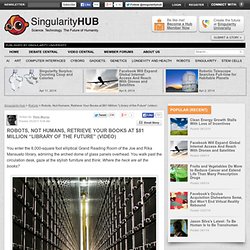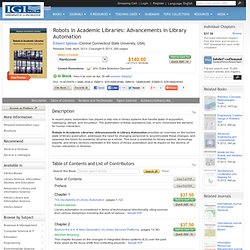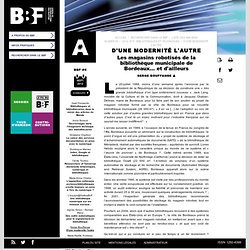

This New Library Of The Future Brings You Your Books Via Robot. In a digital age where many commentators tolled the death knell for the book-bound library, we’ve reported time and time again that the libraries of the future are the ones that react and adapt to new technology, not run from it.

A library that’s recently opened embodies this philosophy. The James B. Hunt Library at North Carolina State University blends novel technology with exciting design by Norwegian architecture firm Snøhetta. The most exciting new feature in the library is probably the bookBot, a robotic book-delivery system that will automatically retrieve books for students once they select them from a virtual catalog. The books will be stored in 18,000 underground bins, in high-density shelving units that can hold 2 million volumes in one-ninth the space of normal shelves. Other technological and architectural highlights include:
Hunt Library: bookBot. At the core of the Hunt Library is the bookBot robotic book delivery system, which can store up to two million items in a climate-controlled environment and deliver any of them within five minutes of a click in the online catalog.

Requiring 1/9 the space of conventional shelving, the bookBot helps transform this 21st-century library from a storage facility into a rich environment of learning and collaborative spaces. While the technology underlying high-density automated shelving has been used in large-scale industries such as automotive manufacturing and textiles for many years, it is now becoming a transformational tool for the pioneering research libraries that are deploying it. In the bookBot, books and other items are barcoded, sorted by size, and stored in over 18,000 bins. The system is both fascinating to watch and easy to use.
A Helping Hand: New Library Robot to Aid Access to Materials. A Helping Hand: New Library Robot to Aid Access to Materials Researchers in the Digital Knowledge Center of the Milton S.

Eisenhower Library have developed, in cooperation with engineers from the Whiting School of Engineering, a working prototype of a library retrieval robot, which is called Comprehensive Access to Print Materials, or CAPM. As more and more print materials are moved to off site storage facilities, research universities face the challenge of maintaining large collections of materials, while maintaining access by library users.
The CAPM robot, which can now retrieve materials from a test storage shelf and deliver it to a scanning bed, will one day be able to retrieve and scan materials, based on users' requests. University of Chicago's Robotic Library Makes Your Librarian Obsolete. Robots, Not Humans, Retrieve Your Books at $81 Million “Library of the Future” (video) You enter the 8,000-square foot elliptical Grand Reading Room of the Joe and Rika Mansueto library, admiring the arched dome of glass panels overhead.

You walk past the circulation desk, gaze at the stylish furniture and think: Where the heck are all the books? Can't quite reach the top shelf? This robotic crane will be more than happy to help The answer to your question–the books are tightly packed in bins stacked five stories high beneath your feet–is the reason University of Chicago’s new Joe and Rika Mansueto Library is being referred to as the library of the future. An automated storage and retrieval system (ASRS) involving huge, computer-activated robotic cranes find the book you want, deliver it to the circulation desk, and eventually return it back underground.
I thought the switch from the Dewey Decimal system was big. The Mansueto library was recently opened to the faculty and students of the University of Chicago. Where are all the books? Library Test Kitchen. Biblio: your friend in the library of the (near) future. Robots in Academic Libraries: Advancements in Library Automation (9781466639386): Edward Iglesias: Books. Library, information, and computer scientists, mostly in the US but with a voice from Brazil, sift through those tasks at libraries that can be reduced to algorithms and so assigned to machines, and those that require skills only humans can be expected to acquire over the next generation or so of both humans and machines.

Their topics include the inevitability of library automation, a short history with recent trends of automation and collection management, the myth that information and library science has to be stressful, the development of academic library automation in Brazil, maximizing technology to minimize risk, and lending and borrowing library materials. – Annotation ©2013 Book News Inc. Le B.A. BA de l’ABS. Les coulisses.

Parcours d'un livre de la Bibliothèque National de France, BNF. 2012-5 : Bibliothèques et techniques : Sommaire. Des livres aux machines. Le livre à l’heure du numérique devient-il une machine ?

Quels impacts ont les dispositifs numériques sur la lecture et sur notre relation à la culture ? À propos de data.bnf.fr. Current Version This site, which has been available online since July 2011, is continuously being developed and undergoes regular updates. The version currently displayed is Version [1.3] of data.bnf.fr, posted online on 2014/03/25. How to retrieve data from data.bnf.fr: download the data.bnf.fr dump file as of 2014/03/25. D'une modernité l'autre.
Le 20 juillet 1988, moins d’une semaine après l’annonce par le président de la République de sa décision de construire une « très grande bibliothèque d’un type entièrement nouveau », Jack Lang, ministre de la Culture et de la Communication, écrit à Jacques Chaban-Delmas, maire de Bordeaux, pour lui faire part de son soutien au projet de magasin robotisé formé par la ville de Bordeaux pour sa nouvelle bibliothèque municipale (26 000 m²) : « Il en va […] de l’adoption ou non de cette solution par d’autres grandes bibliothèques tant en France que dans d’autres pays.

C’est là un enjeu motivant pour l’industrie française qui ne saurait me laisser indifférent 1. » Dans les années 1990, le système est visité par des professionnels du monde entier. Qu’est-ce qui a pu conduire en si peu de temps à un tel revirement ? La réponse à ces questions ne saurait être unique ni simple. . « Voir grand » Bibliothèques et Technologies d'automatisation.